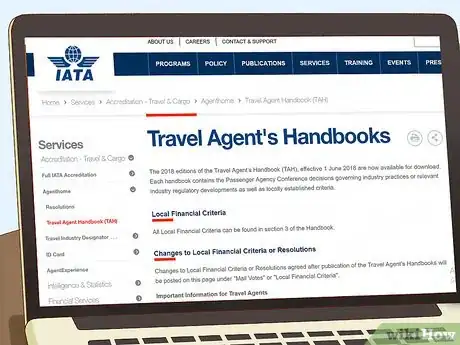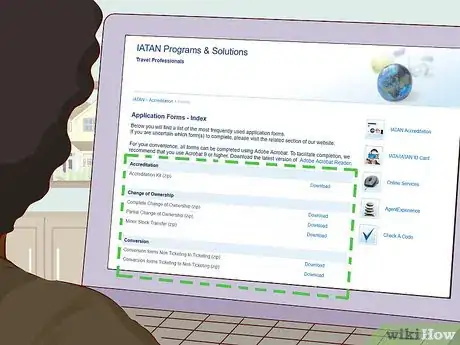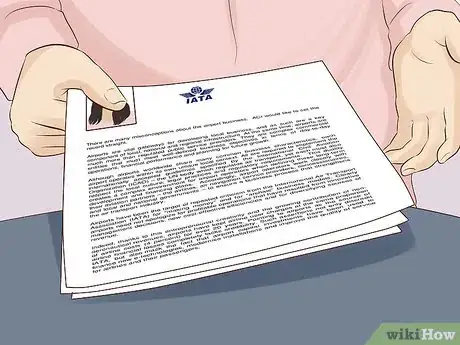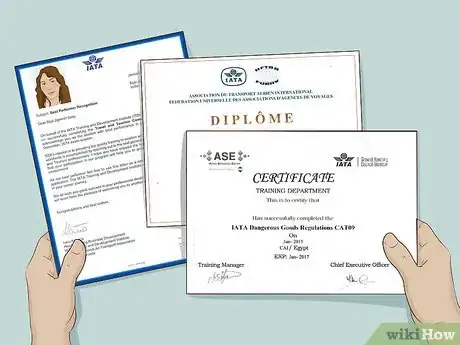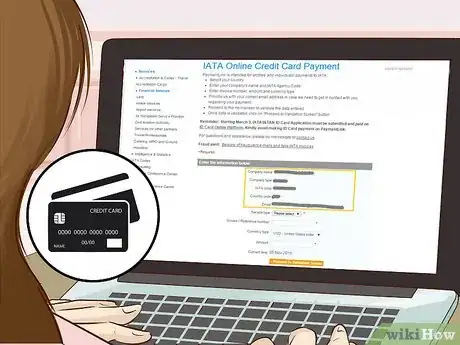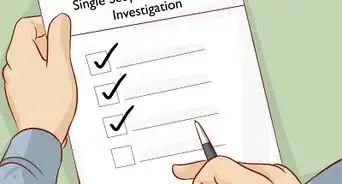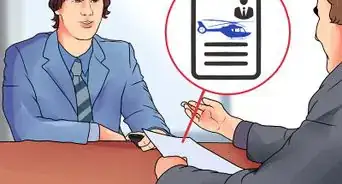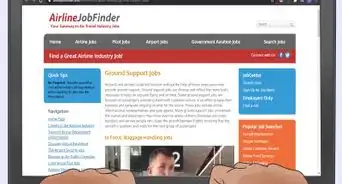This article was co-authored by Shannon O'Brien, MA, EdM. Shannon O'Brien is the Founder and Principal Advisor of Whole U. (a career and life strategy consultancy based in Boston, MA). Through advising, workshops and e-learning Whole U. empowers people to pursue their life's work and live a balanced, purposeful life. Shannon has been ranked as the #1 Career Coach and #1 Life Coach in Boston, MA by Yelp reviewers. She has been featured on Boston.com, Boldfacers, and the UR Business Network. She received a Master's of Technology, Innovation, & Education from Harvard University.
This article has been viewed 70,338 times.
As a travel agent, International Air Transport Association (IATA) accreditation is one of the best ways to take your career to the next level. To secure your IATA certification, we’ll show you how to complete the initial application, answer the questionnaire, and provide documentation of your experience. Although the application process can feel quite overwhelming, rest assured that we’ve got your back. You’ll have your certification in no time!
Steps
Starting the Application Process
-
1Create an IATA online customer profile. Go to http://www.iata.org/customer-portal/Pages/index.aspx and click on the “Not Yet Registered?” link. You will then be asked to enter your email address and personal contact information. You'll also need to select a profile password for future use.
- If you have questions for IATA or need to check the status of your application, you can do so through your personal portal.
-
2Read through the Travel Agent's Handbook. This is an electronic publication that can be found on the IATA website's http://www.iata.org/services/accreditation/travel-tourism/Pages/tah.aspx. It contains detailed information regarding applying for certification and how to stay certified over time. After you've worked your way through the text, reach out to IATA customer service with any questions.[1]Advertisement
-
3Download an application packet. Once you open up iatan.org/Documents/accreditation-kit.zip, you'll see a full accreditation kit with step-by-step instructions. You can either save this document and fill it out as a pdf for email submission or print everything out to mail it in. Alternatively, you can go to the link for “Accreditation Application” found in your IATA personal portal website to submit everything online.
- You can also download the application packet at http://www.iatan.org/accreditation/Pages/application-forms.aspx.
-
4Complete the initial application. This document is in the form of a basic questionnaire. It will ask for contact information at the start. Then, it progresses on to more detailed questions to verify your eligibility for certification.
- Your application will be assessed by the local AIP on the basis of the following criteria: financial record and standing; staff qualifications and experience; identification and accessibility of premises; and security and procedures.
- Do not embellish or lie on a resume. For example, say you have five years of experience when you have only five months of experience.
- Do not say you went to a school, college, or prestigious high school if you did not go to it. The systems and teams can research and find out the truth.
- Do not try to bulk up a resume with a bunch of fillers. It's okay if it's a half-page resume if that's all you have at that time. People have short attention spans. So make the content clear.
Meeting IATA Evidence Standards
-
1Provide evidence of your regular business operations. Print out documents from your official website showing the hours that you provide services to customers. It's also helpful if you can attach a copy of your agreement to serve as a branch of a larger corporation.
- If you are not part of a branch, then you'll need to provide documentation showing that you are a solo operator and provide only inclusive tour offerings.
-
2Document the qualifications of your staff. If you are an agency with multiple agents, then you must show that at least 1 of them has met the professional criteria to operate a business in your local area. If you are a solo agent, then you must submit your business license or copies of any other certifications that you've received. These documents serve as proof of qualifications.[2]
- For example, training courses can count towards showing a minimal level of experience and training required to become certified, as long as they were offered by the IATA. Scan in and submit copies of any training certifications.
-
3Send along proof showing prior travel experience. If you've worked for an IATA accredited agent or airline in the past, then include this information in your resume and application materials. If you can send along a letter from that employer or documentation of employment, then that's even better.[3]
- The IATA is particularly interested in experience that shows a prior knowledge of airline operations and ticketing procedures.
- You could even submit a copy of a prior business card as proof of travel employment experience.
-
4Provide financial and bank statements from the last year. The IATA will only certify agents or agencies that are on firm financial footing. As part of your application package, send along copies of all of your professional bank transactions for the past year at least. Any loan or insurance paperwork pertaining to your agency should also be included.[4]
- Put these materials in chronological order, so that the AIP can browse through them quickly.
- Include the full bank account records showing both deposits and withdrawals for the prior year.
Submitting Your Application
-
1Submit the application and evidentiary materials via email, mail, or the portal. Once your application is completed, if you started it on the portal, then simply follow the prompts to submit it online. Otherwise, you can email a pdf version of your application to: info@iatan.org. Alternatively, you can mail in a printed copy of your application to the IATA headquarters.
- The IATA mailing address for applications is:
703 Waterford Way, Suite 600
Miami, Florida USA
33126. - Your notarized evidentiary documents must be submitted at the same time as your application. Scan them in and submit them as pdfs via the portal or email. Or, keep them in print form and mail them in.
- The IATA mailing address for applications is:
-
2Pay the accreditation fee once you are contacted by the IATA. This fee is payable in U.S. dollars and is due after the IATA acknowledges receipt of your application forms. They will then send you an instruction sheet listing your fee amount and how to pay. You'll have to log in to your patient portal in order to pay your fee with a credit card.[5]
- The fee is usually around $165 for self-employed agents and over $300 for full or corporate travel agencies.
-
3Send along any additional materials as requested. After an initial review of your application, the AIP might contact you to ask for more information or documentation. If this happens, get the materials together for them as quickly as possible. In most cases, they are simply trying to fill in gaps from your application timeline.
- For example, they might ask that you send along a particular financial statement that might have been left out from the prior packet.
Finalizing and Maintaining Your IATA Certification
-
1Receive notification of your certification. When your application has been approved you will get an official letter showing the date of your accreditation. You'll also receive a certificate to display in your office. The acceptance documentation will show your IATA numeric code, which is a unique ID that you'll use for future IATA transactions.[6]
- It will take at least 2 weeks for your application to be approved.
-
2Request reconsideration of a rejected application. If the IATA panel turns down your request for certification, then they will notify you of your exact reasons for rejection. This gives you a chance to strengthen your application and ask for a review. You can request a review within 30 days of your initial application's rejection.
-
3Notify the IATA with name or location changes. If you are an IATA member and decide to change some of your basic membership details, then you'll need clearance from the IATA beforehand. Contact your local branch representative and discuss your plans. Failure to do so could jeopardize your IATA certification status.
-
4Comply with any requests for future accreditation reviews. The IATA reserves the right to ask for evidence of good financial standing at any point during your membership period. If you receive a request for business documentation from the IATA, comply as soon as possible.
- These periodic and random reviews are required of all IATA members.
Community Q&A
-
QuestionWhere is the IATA office for Suriname?
 Community AnswerIATA doesn’t have an office in Suriname. They have an office for all of the Americas, which is in Miami, Florida.
Community AnswerIATA doesn’t have an office in Suriname. They have an office for all of the Americas, which is in Miami, Florida. -
QuestionWhat's the meaning of DOT?
 DonaganTop AnswererDepartment of Transportation.
DonaganTop AnswererDepartment of Transportation.
Warnings
- You must have a clean financial standing in order to apply for IATA certification. Filing for bankruptcy or holding large debts can disqualify your application.⧼thumbs_response⧽
References
- ↑ http://www.iata.org/services/accreditation/travel-tourism/Pages/tah.aspx
- ↑ https://bizfluent.com/how-6079802-become-licensed-iata-travel-agent.html
- ↑ https://bizfluent.com/how-6079802-become-licensed-iata-travel-agent.html
- ↑ https://bizfluent.com/how-6079802-become-licensed-iata-travel-agent.html
- ↑ https://bizfluent.com/how-6079802-become-licensed-iata-travel-agent.html
- ↑ https://bizfluent.com/how-6079802-become-licensed-iata-travel-agent.html
About This Article
The International Air Transport Association or the IATA regulates the aviation travel industry around the world, and travel agencies apply for IATA certifications to demonstrate their qualifications. To become IATA certified, you’ll need to answer a questionnaire and provide documentation of your experience and financial standing. Download the application packet from their website and complete it to get started. You can then prove your regular business operations by submitting your business license and copies of other certifications you’ve received. After that, you can provide your financial and bank statements from the previous year. To learn how to submit your application, keep reading!

